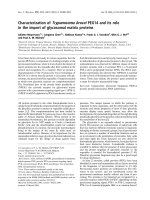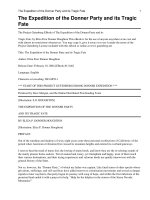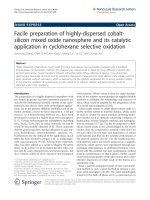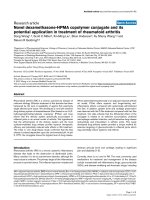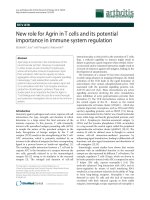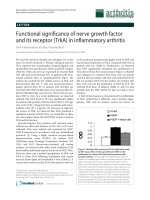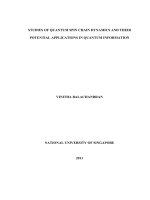Characterization of carbonated steelmaking slag and its potential application in construction
Bạn đang xem bản rút gọn của tài liệu. Xem và tải ngay bản đầy đủ của tài liệu tại đây (575.84 KB, 8 trang )
Vietnam Journal of Science and Technology 57 (3A) (2019) 61-68
doi:10.15625/2525-2518/57/3A/14078
CHARACTERIZATION OF CARBONATED STEELMAKING
SLAG AND ITS POTENTIAL APPLICATION IN CONSTRUCTION
Tran Anh Tu, Tran Gia Huan, Nguyen Ngoc Tri Huynh, Nguyen Khanh Son*
Dept. of Silicate Materials, Faculty of Materials Technology, Ho Chi Minh City University of
Technology (VNU HCM), 268 Ly Thuong Kiet, District 10, Ho Chi Minh city
*
Email:
Received: 31 July 2019; Accepted for publication: 26 August 2019
Abstract. In the south of Viet Nam, steelmaking slag is commonly considered a normal
category of solid waste. And they exist the fact that slag occupies the ground for dumping and
may lead to serious environmental issues due to their high content of heavy metal and fine dust.
In this paper, we aim to analyze the influence of the accelerated carbonation condition in the
laboratory on the physio-chemical properties of carbonated steel slag. Materials composition
was characterized by using different analysis techniques of XRD, SEM, TG and others
measurements of the physio-properties (density, loss on ignition L.O.I.) were also realized with
regard to the requirement of national standard TCVN 7570:2006 for concrete aggregate. In
conclusion, we will discuss on the effect of reaction condition and on the feasibility of
implementing this specific treatment method on the industrial scale.
Keywords: steelmaking slag, solid waste, CO2 sequestration, accelerated carbonation, concrete
aggregate.
Classification numbers: 2.9.4, 3.2.2, 3.3.3.
1. INTRODUCTION
Steel slag, generated from a converter furnace, is a by-product of the process of
steelmaking through smelting pig iron and/or steel-scrap. The molten liquid is a complex
solution of silicates and oxides that solidifies after cooling phase [1]. As an estimation, 15 % by
weight of the steel product is slag by-product. That means each ton of final steel product goes
together with 150 kg of the solid waste of slag. Depending on the type of converter furnace, the
named the generated slag as follows: EAF steel slag, BOF steel slag or Ladle steel slag [2]. The
technology of Electrical Arc Furnace (EAF) is often used to refine steel scrap. Iron scrap is also
the primary feedstock of almost steel plant in South of Vietnam due to a shortage of iron ore
from mines. In Ba Ria - Vung Tau province, they estimate that the annual production a total of
13 steelmaking plants is around 3.75 million tons [3]. In one hand, they meet the local needs in
the current context of the rapid growth of urbanization in this region and in the others hand, the
contribution of steel production is one of the main export products. But, as a consequence, they
discharge a huge amount of 412.000-562.500 tons of slag and a high volume of CO2 emission.
Both of them cause serious environmental issues that relate to soil, groundwater and air. As we
Tran Anh Tu, Tran Gia Huan, Nguyen Ngoc Tri Huynh, Nguyen Khanh Son
know, CO2 emission is now considered as the main cause of climate change in the world. In
practice, slag dumpsites are now expanding over the year at steel plant’s site due to the fact that
they exist no strategic plan for recycling this solid waste [3]. Also, as mentioned in the reference
[3], they exist somewhere the information about the successful application of steel slag as
material for leveling, soil improvement, coarse aggregate for asphalt and/or cement concrete,
etc. But at the same time, they also exist much fearfulness considering environmental impact
and/or toxicity of steel slag due to heavy metal and/or other existing impurities. In terms of
technology, the issue of volumetric instability due to the high content of CaO, MgO in slag
composition and the remaining steel scrap due to the smelting process of electrical arc furnace
equipment. The remaining steel scrap might lead to potential corrosion and increasing
temperature while exposed to weathering conditions. Slag potential expansiveness might lead to
the destruction of the coarse aggregate of concrete and global damage of the concrete structure.
Seen as a whole, these contradictory arguments limit the feasibility of slag aggregate in the
practical application of construction works. Despite the fact that the re-utilization of steel slag in
civil works guarantees several benefits related to the environmental safeguard in terms of natural
resources preservation (avoiding onerous quarrying processes) and waste disposal reduction.
In principle, the phenomenon of mineral sequestration consists of the capture reaction of
CO2 gas of Ca and Mg silicate mineral-bearing rock and/or hydroxide compound to transform
those materials to stable and solid forms of carbonates mineral [4]. As reported by Huijgen et al.,
the fundamental concept behind the mineral sequestration is the classical principle of natural
rock weathering. But, in general, the carbonation reaction in nature is very slow and could only
be achieved after many years. It has been identified as one of the major challenges for largescale mineralization of CO2 [5]. Although, researchers and industry agree together that this is the
most effective and eco-friendly process of CO2 capture and storage. Research on further
enhancement of the mineral carbonation reaction may contribute to the development of costeffective CO2 sequestration on a large scale of on-site mineral sequestration. As analyzed in the
first paragraph, CO2 emission and potential expansiveness are two key points that we must take
into account a viable way of recycling steel slag [6,7]. To combine those two factors in a mature
technology of mineral sequestration is challenging and becoming an intensive business under the
circumstance of economic demand and environment impact. Huijgen et al. [5] were the first to
conduct a systematic study of the reaction mechanisms of CO2 sequestration by carbonation of
steelmaking slag through an alkaline solid. From that, many types of research in literature
present various acceleration approaches to overcome the kinetics barrier of the carbonation
reaction of steel slag.
In the next paragraph, we will investigate the influence of the accelerated carbonation
condition on the physio-chemical properties of carbonated steel slag. This study is remaining at
the laboratory demonstration scale before putting the concept into practice. We aim to take into
consideration the factor of particle size of slag gravel by maintaining the reaction condition at
the same CO2 content and relative humidity. The reaction temperature was maintained at room
temperature conditions (approx. 30 ± 2C). The results of materials analysis both in terms of
mineralogical composition and intrinsic character will be discussed. In the end, we aim to
highlight the effect of the reaction condition on the carbonation of steel slag and also to
anticipate the feasibility of implementing this specific treatment method in practice.
2. MATERIALS AND EXPERIMENT IN CARBONATION CHAMBER
2.1. Preparation of slag aggregate
62
Characterization of carbonated steelmaking slag and its potential application in construction
Rough gravel of slag (particle size > 800 mm) was collected from the dumpsite of Vietnam
steel plant in Ba Ria – Vung Tau province. We used laboratory jaw crusher to reduce the particle
size of slag grain and at the same time used a permanent for iron removing. After that, slag
gravels were sized by using two sieves 4.75 and 37.5 mm. The last means we obtained 2
categories of particle sizes as given in Figure 1: coarse slag aggregate 20-40 mm and fine slag
aggregate 2.5-5 mm as usually distinguished in the concrete aggregate component. Those two
categories will be placed in the carbonation chamber in the next step to investigate the effect of
particle size on the reaction rate.
Figure 1. Preparation of two categories of steel slag aggregate: coarse slag 20-40 mm and
fine slag 2.5-5 mm.
We attempt to measure density, water absorption and loss on ignition of slag with regard to
the criteria values of the national standard for concrete coarse aggregate such as the case of
calcite. The averaged result of a specific density was 3.51 g/cm3, showing a higher density
(3.51 g/cm3 vs. 2.65 g/cm3) than natural calcite. The last is probably due to the presence of
remaining iron scrap in slag. The result of water absorption was 1.7 ± 0.5 %wt that is slightly
higher than 0.5 %wt of calcite aggregate. But considering the intrinsic porous microstructure of
the slag aggregate, the obtained result of water absorption could be much more important. In
addition, the porous microstructure of slag might make an impact on the mechanical strength of
the slag aggregate. The measured value of a loss on ignition was 6.5 %wt, that could be linked to
different thermal decomposition of mineral composition of slag. This statement was clarified
with the result of XRD analysis (D8 ADVANCE, Bruker-Belgium) that revealed main mineral
components of steel slag including calcite, free lime, alite and portlandite, etc.
2.2. Accelerated carbonation chamber and saturated salt solution
Figure 2. Design schematic of the accelerated carbonation chamber in the laboratory.
The accelerated carbonation chamber was previously designed and implemented in the
laboratory [8]. As given in Figure 2, the chamber contains two units: the left one serves for
63
Tran Anh Tu, Tran Gia Huan, Nguyen Ngoc Tri Huynh, Nguyen Khanh Son
sample storage and the right one serves for air mixing. A ventilation fan and air duct permit the
easy circulation of mixing air between the left and right unit. CO2 gases are supplied from
compressed air tank into the mixing unit using controlled flow valve. The CO2 sensor is installed
to control the changing value of gas concentration. Value of relative humidity inside the
chamber also is recorded continuously thanks to the installation of a digital humidity meter.
Besides that, the temperature inside the chamber is also a normal room temperature condition
(approx. 30 ± 2 C) and is showed by the digital meter. It is noted that humidity is one of the
controlled factors of the carbonation reaction of slag aggregate inside the chamber. In this study,
we used a saturated salt solution for stabilizing the moisture content. Those solutions were
placed in a number of pans next to the trays of slag gravel in the left unit (Figure 2). The high
surface area of salt solutions stored in those pans allows its either absorb or desorb water in
order to maintain the equilibrium relative humidity (RH). According to Young, by using a
saturated salt solution of sodium chloride (NaCl) and barium chloride di-hydrate (BaCl2.2H2O),
we could respectively stabilize the moisture content 80 ± 2 % and 97 ± 2 %. In addition, to
combine the use of the two saturated salts solutions, we could stabilize the moisture content 90 ±
2 % at room temperature [9].
2.3. Operation of accelerated carbonation chamber
We first carried out the process of operating in idle mode the carbonation chamber in
laboratory condition. The variation of moisture content and CO2 concentration were
investigated. Figure 3 shows the obtained results during one week. As given in Figure 3 (left),
measured values of the moisture content were stabilized at 80 %, 90 %, 99 % thanks to the use
of the saturated salt solution. The variations of CO2 content were also slightly small around the
medium value of 7 %. It seems that such variations depend on the moisture condition due to
possible dilution of gaseous in the salt solutions. From the results of the operation in idle mode,
we can point out the good performance of the developed chamber for experimental study of slag
carbonation. In this step, two categories of slag aggregate (coarse and fine grain) were
introduced into the chamber for accelerated reaction under three above moisture conditions.
After 3 weeks, we carried out different characterization tests for those carbonated slag samples.
RH 90%
RH 80%
CO2 content (%)
Moisture content (%)
RH 99%
Days running in idle mode
RH 99%
RH
90%
RH 80%
Days running in idle mode
Figure 3. Variation of moisture content (%) and CO2 concentration (%) of carbonation chamber running
in idle mode for one week.
3. RESULTS AND DISCUSSION
3.1. Materials analyzing of carbonated steel slag
64
Characterization of carbonated steelmaking slag and its potential application in construction
We conducted a study of the evolution of the material composition of the carbonated slag
by using XRD (D8 ADVANCE, Bruker-Belgium), SEM (S-4800, Hitachi-Japan) and TG
(LABSYS evo STA, Setaram-France) analysis. To minimize the number of analysis, only slag
samples prepared under 6 % of CO2 content and 97 % relative humidity were investigated.
Figure 4 reveals the results of the mineral composition of steel slag (coarse and fine particle)
compared to the controlled sample of slag before the carbonation reaction. We highlight the peak
of calcite (N01) and lime (N08) in the pattern of the results of XRD analysis. The intensity of
calcite peaks was relatively prominent with regards to background noise linked to amorphous
glassy phase. Other phases of minor minerals including alite, wuestite , etc. were also recognized
but with low intensity peaks. To compare with XRD pattern of the controlled sample, we could
not recognize the peak of calcite but they existed the peaks of hydrated lime. The last mean
thanks to the carbonation reaction hydrated lime transformed into calcite mineral by uptaking
CO2 of the chamber. But the reaction was not complete after 3 weeks due to the presence of
hydrated lime in the final product.
Intensity (au)
1: Calcite
2: Lime
3: Alite C3A
4: Magnesio ferrite Mg2Fe2O4
5: Perovsite
6: Olivin Mg2Fe2SiO4
7: Wuesite Feo
8: Porlandite
Fine grain of
slag aggregate
Coarse grain of
slag aggregate
Controlled slag
Figure 4. XRD patterns of carbonated steel slag and controlled sample of slag before carbonation reaction.
Figure 5 shows SEM photos of steel slag samples before and after carbonation. They
reported a significant change in the microstructure of steel slag sample after 21 days under the
accelerated carbonation condition. In the photo on the right hand side, the morphology of calcite
crystal in rods could be found abundantly thanks to carbonation reaction. The result also
confirmed the peaks of calcite mineral in the above XRD patterns.
Figure 5. SEM photos of steel slag samples before and after carbonation.
65
Tran Anh Tu, Tran Gia Huan, Nguyen Ngoc Tri Huynh, Nguyen Khanh Son
Figure 6 shows the results of TG analysis of steel slag samples before and after 21 days
under accelerated carbonation condition (99 % relative humidity, room temperature, 6 % of CO2
content). In general, we noted a significant difference in total mass loss of these two sample
series. They were respectively 5 %wt and 15 %wt in the range of temperature between 30-900
C. As given in the TG curve, we can distinguish into 3 mains stages of mass loss. The first stage
is in the range of temperature between 30 and 105 C which corresponds to water evaporation.
The second stage is in the range of temperature between 150 and 600 C which corresponds to
different dehydration reaction of mineral phases (hydrated C-S-H, hydroxide Ca(OH)2…) and/or
transition of iron oxide compound. The third stage is in the range of temperature between 600
and 900 C which corresponds mainly to decomposition reaction of CaCO3. Therefore, except
the first stage that is usually the same value for two series of controlled slag sample and
carbonated slag sample, results of mass loss of second and third stage of carbonated slag sample
were clearly higher than those of controlled slag sample due to the contribution of different
calcite mineral phase in two sample series.
(A)
Notes:
(A): Controlled slag sample
(B): Carbonated slag sample
(99% RH, 6% CO2 content,
room temperature)
(B)
Figure 6. TG curve of two sample series controlled slag and carbonated slag sample.
3.2. Material properties of carbonated steel slag
After carbonating 21 days in the chamber, we conducted a study on material properties
such as measurement of loss on ignition and density for both coarse and fine slag aggregate. It
should be noted that besides the influence of particle size of steel slag, different humidity has
also been studied to discuss possible impacts.
Figure 7 reveals the evolution of the measured value of density over 21 days time of
accelerated carbonation for two categories (coarse and fine aggregate) of steel slag.
Measurement of density was realized respecting to the instruction of Vietnamese standard
TCVN 7570-4:2006 (for concrete aggregate). Typically, the value of density increased in
function with time and reached the average value of 3.64; 3.68 or 3.71 g/cm3 depending on the
humidity condition. It should be noted that the initial value of the density of the slag was 3.51
g/cm3 as reported in section 3.1. Compare two categories of steel slag sample, it seems that the
fine particle of slag aggregate revealed slightly higher density and also the earlier rate of
conversion. With regards to the obtained result of materials analysis in section 3.1, such an
evolution of density could be absolutely linked to the phenomenon of carbonation. Fine grain of
steel slag seems to be easier uptaking CO2 gaseous in order to transform hydrate lime into
calcite. We can explain this result by considering the evidence that high surface area of fine slag
aggregate provides better contact solid-gaseous reaction than the low surface area of coarse slag
aggregate. Furthermore, the effect of high humidity condition on the reaction rate was clearly
66
Characterization of carbonated steelmaking slag and its potential application in construction
shown in Figure 7. The optimal condition for carbonation of coarse and fine aggregate of steel
slag was under 99 % moisture content and room temperature.
Coarse grain of slag aggregate
RH 99%
RH 90%
RH 80%
Relative density (-)
Relative density (-)
Fine grain of slag aggregate
RH 99%
RH 90%
RH 80%
Days of carbonation in the chamber
Days of carbonation in the chamber
Figure 7. Evolution of specific density of two categories of steel slag aggregate (fine and coarse grain).
In Figure 8, we can see the measured values of loss on ignition of carbonated slag which
was distinguished by two categories of coarse and fine aggregate. The test of loss on ignition
L.O.I was realized with slag powder according to the instruction of Vietnamese standard TCVN
7570-7:2006 (for concrete aggregate). As previous results of specific density, those values of
loss on ignition evolve over time of placing in the carbonation chamber. That means due to the
progress of the carbonation process, an amount of hydrate lime converted into calcite mineral
and make increasing the final mass loss. Compare two categories of steel slag sample, L.O.I of
the fine grain of slag aggregate on the left hand figure showed more important than L.O.I of the
coarse grain of slag aggregate on the right hand figure. The last means that the rate of
carbonation reaction is more important in the case of the fine slag aggregate. However, after 21
days, it seems that the results of L.O.I of coarse slag aggregate keep increasing trend. Such
tendency could be explained by the uncompleted reaction of carbonation of steel slag. We did
not identify the same phenomenon in the case of fine slag aggregate. With regards to the effect
of humidity condition, we obtained the same result as the result of specific density. That means
99 % moisture content was the optimal condition for the carbonation reaction of steel slag for
both of coarse and fine grain. The reaction rate was also slightly high at the beginning period
and achieve early the final state of carbonation with a small variation of L.O.I between 12 and
21 days.
Coarse grain of slag aggregate
RH 99%
RH 90%
RH 80%
Days of carbonation in the chamber
Loss on ignition (%wt)
Loss on ignition (%wt)
Fine grain of slag aggregate
RH 99%
RH 90%
RH 80%
Days of carbonation in the chamber
Figure 8. Evolution of measured L.O.I of two categories of steel slag aggregate (fine and coarse grain).
67
Tran Anh Tu, Tran Gia Huan, Nguyen Ngoc Tri Huynh, Nguyen Khanh Son
4. CONCLUSIONS
To conclude, the use of the acceleration carbonation chamber in the laboratory is necessary
to optimize the reaction condition of steel slag before putting the concept of technology into
practice. The result of materials analysis such as XRD, SEM, TG confirmed the presence of
abundant calcite in the carbonated steel slag in the accelerated condition. The effect of relative
humidity (99 %) on the carbonation reaction of slag must be also taken into account. The
carbonation process took place more intensely during 3 weeks placing in the chamber thanks to
the honeycomb structure of steel slag aggregate. The effect of different particle size of slag
aggregate on the carbonation progress was also clarified. The fact that higher the surface area of
fine slag aggregate provides better contact conditions for the carbonation reaction than low
surface area of coarse slag aggregate. Thus, the progress of carbonation reaction in the
accelerated carbonation chamber helps us decrease free lime in slag and convert into stable
calcite mineral. By adopting this technique, the potential expansiveness of steel slag could be
achieved before using concrete. In the future study, we could investigate on the physiomechanical properties of carbonated slag aggregate for potential application as aggregate for
cement or bituminous concrete.
Acknowledgments. The research is funded by Ho Chi Minh city University of Technology, VNU-HCM
under grant number T-CNVL-2019-25.
REFERENCES
1.
Shi C. - Steel slag – its production, processing, characteristics, and cementitious
properties, Journal of Materials in Civil Engineering 16 (3) (2004) 230-236.
2.
Yildirim I. Z., and Monica P. - Chemical, mineralogical, and morphological properties of
steel slag, Advances in Civil Engineering Volume 2011 (2011), Article ID 463638, 13
pages (doi:10.1155/2011/463638).
Ecoslag company, Steel slag – green material for future, Technical report, (2012) p.85.
3.
4.
Huijgen W. J. J., Geert-Jan W., and Rob N. J. C.- Mechanisms of aqueous wollastonite
carbonation as a possible CO2 sequestration process, Chemical Engineering Science 61
(13) (2006) 4242-4251.
5.
Huijgen W. J. J., Geert-Jan W., and Rob N. J. C. - Mineral CO2 sequestration by steel slag
carbonation, Environmental science & technology 39 (24) (2005) 9676-9682.
6.
Pan S. Y., Chang E. E., and Pen-Chi C. - CO2 capture by accelerated carbonation of
alkaline wastes: a review on its principles and applications, Aerosol Air Qual Res 12 (5)
(2012) 770-791.
7.
Ukwattage N. L., Ranjith P. G. and Li X. - Steel-making slag for mineral sequestration of
carbon dioxide by accelerated carbonation, Meas. J. Int. Meas. Confed. 97 (2017) 15–22.
8.
Sơn N. K., Huỳnh N. N. T., and Tu T. A. - Experimental study and characterization of
bio-based aggregate concrete under accelerated carbonation condition, Journal of Building
Science and Technology - IBST 4 (2017) 48–54.
9.
Young J. F. - Humidity control in the laboratory using salt solutions—a review, Journal of
Applied Chemistry 17 (9) (1967) 241-245.
68
